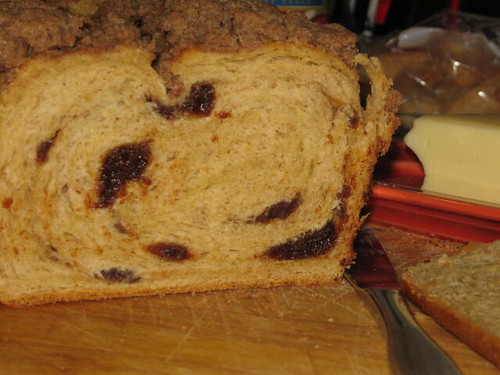In getting started down the path of baking, I'd been having problems with dough failing to rise in the oven or the second time - so the enthusiasm of this bread comes in having the faith to cut my rise times in half sine I was using Fleishman's instant yeast. Once I did this, I was able to get the bread I finally wanted without the disappointment of a heavy, dense loaf that seemed like it should work.
After reading up on the policy of repriting recipes, it seems I'm okay to share how I got to this point. If it's a problem, I do hope someone will let me know. :)
Anyway, husband is a tremendous fan of all things cinnamon and sugar-based, so he was wanting a cinnamon sugar bread since the baking experiment began. When I'd gotten the King Arthur Flour Baking Companion, he zeroed in on the recipe for Cinnamon Swirl Bread on page 206-207. It can seem a bit daunting with the Dough, Filling and Topping ingredients, but let's break it down, shall we?
All of the ingredients pictured (some things premixed):
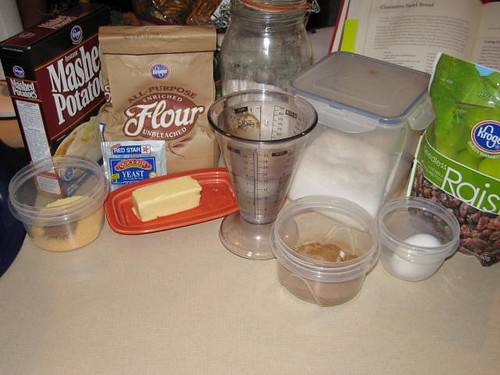
But let's start logically with the DOUGH:
3 cups (12 3/4 oz) unbleached all-purpose flour
1/4 cup (1 1/2 oz) potato flour or 1/3 cup (3/4 oz) potato flakes)
1/4 cup (1 1/4 oz) nonfat dry milk
1 1/4 tsp salt
1/2 tsp cinnamon
3 Tbs (1 1/4 oz) sugar
2 1/2 tsp instant yeast
4 Tbs (1/2 stick, 2 oz) butter
1 cup (8 oz) water
For reference, I opted for the potato flakes and used unsalted butter. All ingredients were at least room temperature.
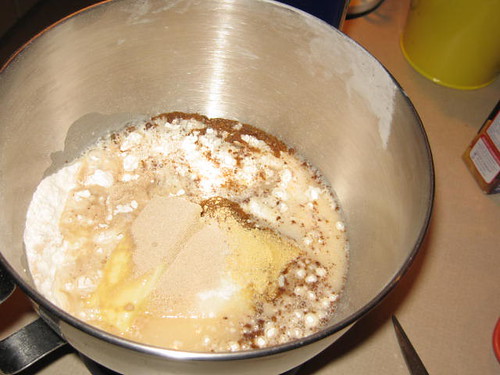
From KAFBC:
In a large mixingbowl, combine all the dough ingredients, mxing until dough begins to come away from the sides of the bowl. Knead (about 10 minutes by hand, 5 to 7 minutes by machine) until the dough is smooth and satiny. Transfer the dough to a lightly oiled bowl, cover the bowl ith plastic wrap and set it aside to rise for 1 to 1 1/2 hours; it will be puffy, if not doubled in bulk.
Once I'm convinced everything's going well enough, I acutally let the mixer do ALL the work on this sucker. I was doing this after work so I took time to go upstairs and change and came back to see that the dough hook had done its job rather nicely (my mixer and I are good friends now):

I check my rise after 45 minutes and do the "poke" test - where I see if my poke sticks. As you can see, I do have a doubled dough and a poke that's more than sticking. So rather than risk tiring out the yeast, I decide to move onto next steps:

Next steps for Cinnamon Swirl Bread involve the FILLING Ingredients:
1/4 cup (1 3/4 oz) sugar
1 1/2 tsp cinnamon
1/4 cup (1 1/2 oz) raisins or currants
2 tsp unbleached all-purpose flour
Egg wash, made from 1 large egg beaten with 1 Tbs water
For my bread, I used raisins. Husband thinks we could have doubled the swirl ingredients. From the book:
Pulse the filling igredients except the egg wash in a food processor.
TO ASSEMBLE: Transfer the dough to a lightly oiled work surface and shape it into a long, narrow rectangle, about 16 x 8 inches. Brush the dough with some of the egg wash (set the remainder aside) and pat the filling gently onto the dough. Beginning with a short edge, roll the dough into a log. Pinch the side seam and ends closed (to keep the filling from bubblng out) and palce te log int a lightly greased 8 1/2 x 4 1/2-inch loaf pan. Cover the pan with lightly greased plastic wrap or a proof cover and let the bread rise for a bout 1 hour at room temperature, or until it's crowned about 1 inch over the rim of the pan.
I actually made this a little bit simpler than it sounds - I laid my loaf pan at one end of the counter and rolled my rectangle towards it as a guide, keeping the width slightly narrower than the pan. The dough was very silky, so I really just sprayed some Pam on my kitchen island for the "lighly oiled" portion of the instructions.
Here's the dough rolled out - you can see my loaf pan "guide" on the far left. I don't know if it's just me, but the cinnamon in the dough really seems to come through for me:
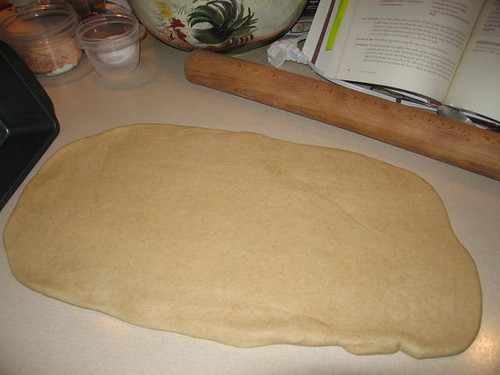
The filling was VERY clumpy (raisins!), so it didn't spready as easily as I would have liked. This is also where the discussion of doubling the filling for future batches came in:
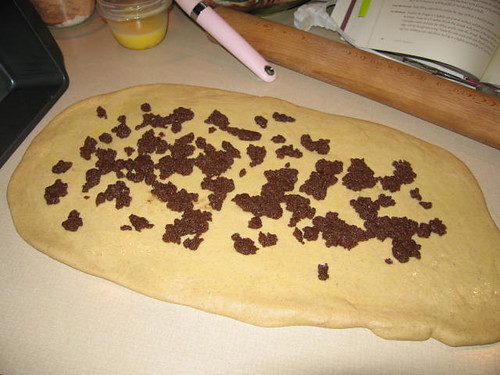
The rolling was actually a snap. I did the side tucking as I went along and went towards my loaf pan:
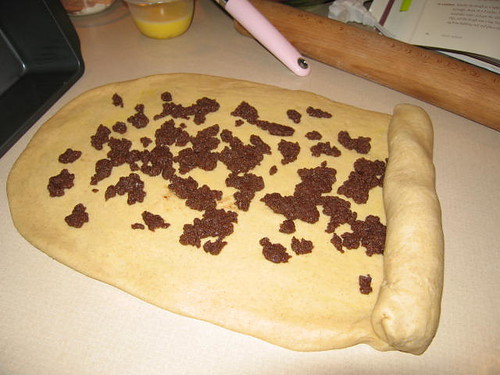
Again, with the rising, I checked out the loaf in only HALF the time - and good thing! Doesn't it look like I'm an inch above the pan?
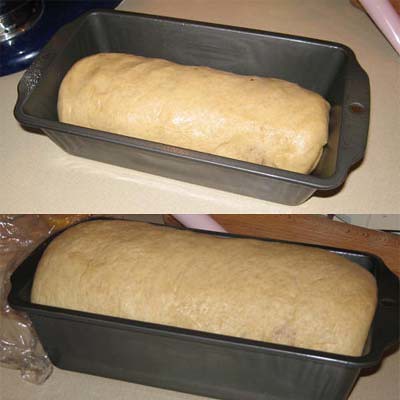
Now for the good suff - the TOPPING:
2 TBS (1 oz) butter
2 Tbs (7/8 oz) sugar
1/4 tsp cinnamon
1/4 cup (1 oz) unbleached all-purpose flour
I will say that this made MORE than enough of the topping. From the book:
In a small bowl or mini processor, combine the butter, sugar, cinnamon and flour until the mixture is crumbly, If you're using a mini processor, watch carefully; topping will go from crumbly to a cohesive mass in just a second or so.
Brush the top of the loaf with some (or all) of the reserved egg wash and gently press on the topping.
Preheat the oven to 350 degrees. Bake the bread for about 45 minutes, tenting it lightly with aluminum foil or the final 15 minutes or so if it appears to be browning to quickly. Remove the loaf from the oven, and after about 5 minutes, quicky remove it from the pan. some of the streusel will fall off, but you can alleviate this by first loosening all around the edges of the loaf with a knife, then turning the pan on its side and gently pulling it away from the loaf. Topping will continue to fall off as you maneuver the bread -- we've never figured out how htey make that stuff adere so nicely on the store-bought loaves -- but you'll still be left with a lot of the sweet topping.
I did actually score the top of the loaf lightly before baking it - you can't really tell, but I did:
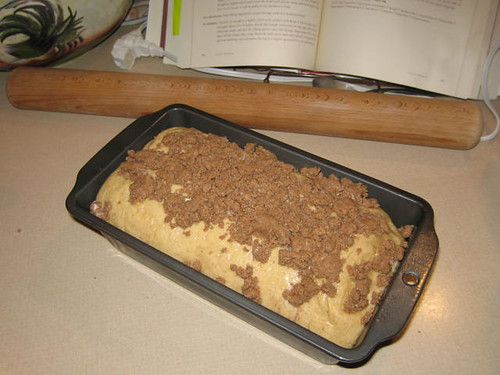
The oven browning was FANTASTIC - we did tent it for a bit to save on some of the browning and you can see that the split did come through (as did a bit of the filling, but that's okay):
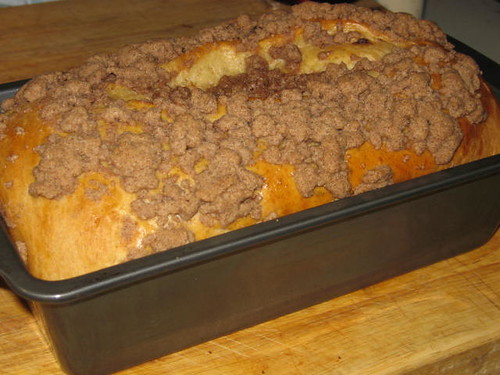
Slicing into the bread was amazing - it smelled fantastic and made GREAT toast and snacks. It was great with cream cheese and peanut butter as well:
